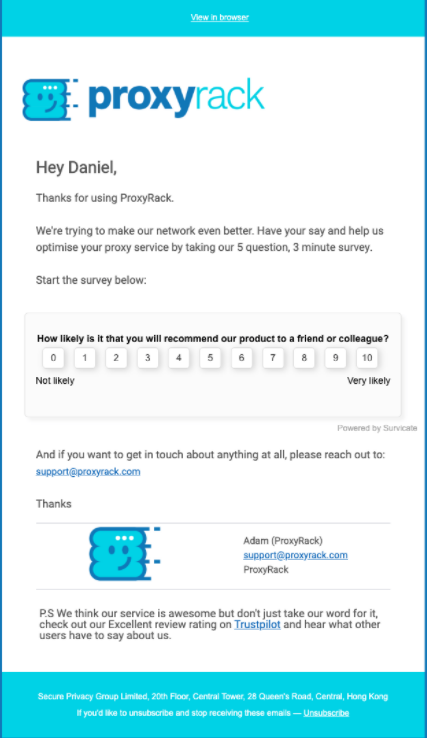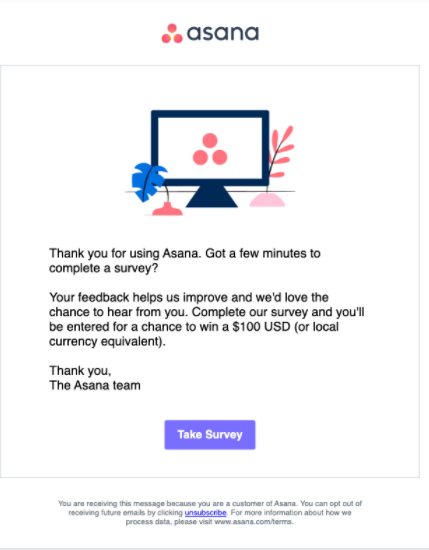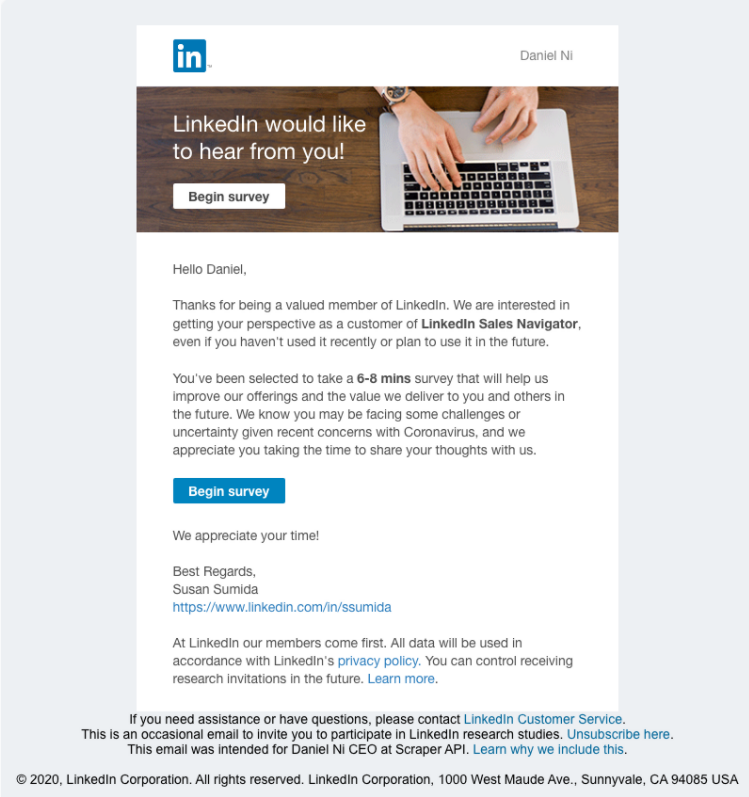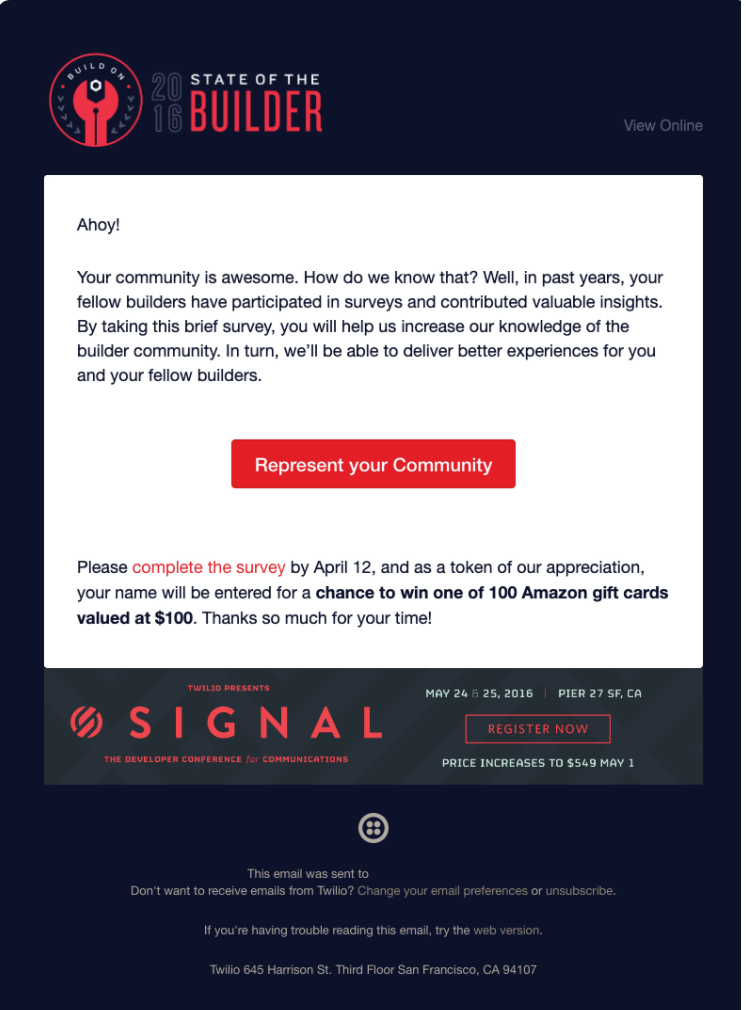NPS Email Examples and Strategies
Net Promoter Score (NPS) is one of the most popular ways to measure customer loyalty. It is wise to use NPS because it is widely understood. Technology companies that use NPS include Dell, Microsoft, Rackspace, Salesforce, SAP, and Symantec (source). By regularly measuring NPS, you can make a better case to investors about the strength of your company.
Before starting to gather data, let’s start by defining a few key terms. NPS works by asking customers a single question: “How likely is it that you would recommend [brand] to a friend or colleague?” on a scale of 0-10.
Scores are further divided into three subcategories: detractor (i.e., NPS score of 0-6), passive (i.e., NPS score of 7-8), and promoter (i.e., NPS score of 9-10)).
Promoters are the Holy Grail of customers! These people love your brand and keep buying from you over and over again. Think about the people who are willing to preorder Apple products on the day they are announced. A promoter’s goodwill to you may include mentioning you at conferences, testing new features, and giving you reviews in the SaaS world. In many cases, a promoter will proactively refer new customers to you without you taking any action.
A passive person is happy customers that don’t think about your company. They are likely to keep an open mind to hearing from a competitor with more attractive pricing, integrations, and features. A passive customer might offer a positive opinion about your product if asked directly by a colleague. However, you cannot expect passive customers to leave reviews or volunteer to give a testimonial or case study.
A detractor person is a relatively unhappy customer who can hurt the company in two ways. First, a detractor is less likely to stay a customer for an extended period. Second, a detractor is likely to spread negative word of mouth (i.e., one-star reviews on Capterra, TrustPilot, and other platforms). Avoiding detractors completely is probably unrealistic. However, you want to take steps to minimize them as much as possible.
According to NetPromoter.com, the Net Promoter Score is calculated in the following way:
Gathering NPS in a B2B SaaS business is important for several reasons.
• Use NPS as a leading indicator vs. competitors. Comparing your company to others on financial metrics like average revenue per user, customer acquisition cost, or revenue per employee only tells you so much. Financial measures are helpful, but they are lagging indicators. Understanding customer satisfaction is a better near-term sentiment.
According to SurveyMonkey, the average NPS for technology companies is 40. To put that number in context, professional services and consumer goods companies typically earn an NPS of 50. Therefore, there is clear room to improve for many technology companies.
• Measure customer satisfaction over time. Tracking NPS over time is a powerful tool to assess if your company’s quality standards are maintained as you grow. If NPS shows a sharp growth in detractors and fewer promoters, that is a warning sign for management. Left unchecked, a low NPS may spell the end of word-of-mouth growth.
The reverse is also true. When you see NPS steadily increase over time, that is an excellent signal. It tells you that you can probably gather a bunch of great testimonials with little effort. In addition, you may have the opportunity to use a “land and expand” strategy at your larger corporate clients. In brief, land and expand strategy means growing from 10 seats at a corporate customer to 100 or more. That internal growth is much easier when you can call on a solid internal promoter for support.
• Use NPS to inform product and investment decisions. NPS can also be used as input in business decision-making. For example, a declining or below average NPS may signal the need to invest in the customer success function. If that function is already in place, the solution may lie elsewhere, like improving the onboarding experience or boosting product reliability.
• Reinforce the importance of the customer. In a growing SaaS company, sales and customer success employees have the greatest opportunity to interact with customers. The rest of the company - development, marketing, finance, and more - lacks that direct customer connection. Monitoring NPS and discussing it regularly with employees gives everybody in the company a sense of customer satisfaction.

Email Credit: ProxyRack
Analysis of ProxyRack’s NPS Email
The ProxyRack email jumps straight to the vital question to gather net promoter score (NPS) data.
• Set Expectations. The ProxyRack email tells the customer exactly what to expect - a 5 question survey that should take three minutes to complete.
• Start With The Most Important Questions. In survey research, it is essential to realize that not everybody will finish all survey questions. As a result, ProxyRack has made an intelligent decision to feature the key NPS question first: “How likely is it that you will recommend our product to a friend or colleague?"
ProxyRack might be able to get additional responses to their email by making a few adjustments.
• What’s In It For The Customer? To be clear, ProxyRack does partially answer this question in the opening of the email. However, the copy is quite company-focused instead of customer-focused. Revising the opening lines of the email to emphasize that the company is serious about feedback may help. For example, ProxyRack might say, “We launched the USA Rotating Proxies service after hearing from customers. We consider your feedback when launching new products.”
• Personalize By Product. The email currently has limited personalization - it is addressed to the customer by the first name. The email could be improved by referencing the specific product the customer uses. Adding specific details like that also helps convince the customer that they are looking at a genuine email rather than spam or phishing emails.
• Personalize By Product. The email currently has limited personalization - it is addressed to the customer by the first name. The email could be improved by referencing the specific product the customer uses. Adding specific details like that also helps convince the customer that they are looking at a genuine email rather than spam or phishing emails.

Email Credit: Asana
Analysis of Asana’s NPS Email
The Asana survey email is distinctive due to its emphasis on the potential reward.
• Offering An Incentive. The customer doesn’t have to wonder what’s in it for them. The company is offering a chance to win $100.
• Unsubscribe Copy. The fine print at the bottom of the email explains why a person has received this email: “you are receiving this message because you are a customer of Asana.” This short disclaimer is beneficial to the recipient. It can also help to remind your internal team members to only send this message to customers rather than everyone on your email list.
Asana can improve its email in a few ways.
• Clarify The Time Commitment. Some online surveys hammer people with seemingly endless questions. Absent any other indication from Asana; customers might fear that they are about to start that kind of long survey. The problem is easy to solve: tell customers how many questions are on the survey.
• Clarify The Reward. The wording of the reward is unclear. The email states: “Complete our survey, and you'll be entered for a chance to win a $100 USD (or local currency equivalent).” The phrasing “win a $100 USD” made me think that the company was offering a gift card (i.e., “win a $100 gift card”) rather than money. If the company is offering money as a reward, make it clear.

Email Credit: LinkedIn
Analysis of LinkedIn’s NPS Email
LinkedIn’s survey email stands out in terms of personalization and relevance. Let’s take a closer look.
• Personalization. The email is personalized on three factors: customer first name and product (i.e., LinkedIn Sales Navigator). Finally, the email is also personalized with a real person on LinkedIn, complete with a link to the person’s LinkedIn profile.
• Clear Time Investment. Before starting the survey, you know exactly what to expect: a six to eight-minute survey.
• COVID-19 Reference. The LinkedIn email is from 2020, so it is no surprise to see that it references the coronavirus pandemic. This principle can be adapted to other circumstances. If there is an industry-wide change that impacts your customers, reference it in the email. You can even position your survey as understanding how your customers are experiencing the problem.
Improving this email is difficult, but we’ll give it a shot.
• Button design. There are two buttons in the email, one near the top and one closer to the button. Looking at the email, it is a bit unclear which one to use. It might be wise to test a simpler design with one button only.

Email Credit: Twilio
Analysis of Twilio’s NPS Email
I chose to highlight Twilio in this chapter because of something unusual they did in their survey email.
• Creative Call To Action. Most survey emails give the user a direct call to action button like “Start Survey.” Twilio took a different approach here with a “represent your community.” That copy repositions the survey as something like a democratic exercise, rather than just another survey.
• Incentive. Twilio’s approach to offering incentives stands out because of the volume. The company states that they are offering one hundred $100 Amazon gift cards. That means that the recipient probably feels like their chance of winning a gift card is much better than other surveys.
• Deadline Driven Pitch. I saved the best for last: Twilio includes a direct pitch to sign up for their annual developer conference in the email. Even better, the email gives the customer a concrete reason to register now - the price goes up on May 1.
There are some ways to make the Twilio email more effective.
• Graphic Design. Generally speaking, black type on a white background is the easiest for people to read. The email follows this rule in the body of the email. However, the fine print at the bottom of the email is tough to read. That might lead some people to think that the company is trying to hide something down there.
• Revise “Brief Survey”. The email asks customers to complete a brief survey. Unfortunately, there is no information provided about just how long the survey is. The email could be improved by providing details about how long the survey will take to complete.
• Revise “Brief Survey”. The email asks customers to complete a brief survey. Unfortunately, there is no information provided about just how long the survey is. The email could be improved by providing details about how long the survey will take to complete.
Sending customer survey emails helps you to accomplish several goals at once. The input you receive helps you to inform your product strategy. Further, strongly positive responses (i.e., promoters) may be willing to share their thoughts in a formal case study, interview or event. If you need more corporate logos on your home page, asking promoters is the fastest way to achieve your goal.
Customer survey emails also reveal problems with your product so you can improve. Think of it this way - customer dissatisfaction will exist whether you hear about it or not. By systematically gathering feedback in a survey, it is easier to persuade others in the team to take action. Absent survey data, you may end up relying on anecdotal responses like negative reviews on websites like TrustPilot, Capterra, or Product Hunt. Gathering feedback through a survey you control is better than letting customers vent their displeasure on public websites. When you get negative comments through a survey, you have the opportunity to respond. Taking the time to show you've heard the complaint and attempting to help the customer solve the problem goes a long way toward addressing customer discontent.
For more welcome email templates, check out the Customer Survey Email Templates section of SaaS Email Templates!

I am the founder and CEO of Messaged, the email marketing automation platform built for SaaS companies.
My email is [email protected] and I am @tldrdan on Twitter; if you have specific feedback or questions related to this guide, I would love to hear from you!
Email Marketing Automation for SaaS Businesses
Start your 14-day free trial or contact sales to book a free demo. Start growing your SaaS business today!